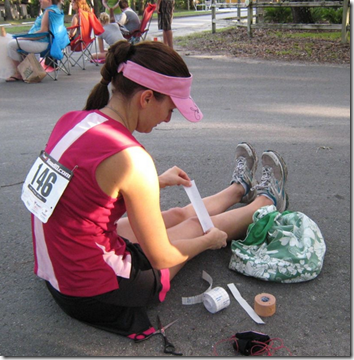When I first started running, I had no idea what I was doing. All I knew was that I really wanted to get my negative behaviors under control and pick up a healthier outlet.
I also wanted to tone up, lose some beer weight, and RACE. I was very interested in racing from the start. It seemed like an easy way to motivate myself – a form of commitment.
I spent the first two years of my ‘running life’ operating under one theory: the more I run, the better I will be. I understood that I needed rest days, but I really always thought that more mileage was better.
Also, running seemed like the most efficient exercise. I could get dressed, run out my front door, and be done with my workout in 30 – 45 minutes. No driving to the gym. No fighting with my bike pump. No waiting for yoga to begin. I really loved to run, too, so I thought doing any other exercise was kind of silly and pointless.
And then… I started to get injured. A lot. In one year alone, I suffered from six or so small running-induced injuries, including a very painful case of Runner’s Knee (here’s how I eventually beat it after a 2.5 month hiatus from running).
I started to question EVERYTHING about my nutrition and training. Why was I getting injured so much and my fellow running buddies were not? I was eating enough calories from quality foods (underfueling is a big cause of injury). I wondered if my body just wasn’t designed for running. I was wearing proper shoes. And I didn’t think I was overtraining.
The trouble was that when I asked myself, “Am I overtraining?†I was looking at overall weekly mileage. I was running 20 miles or so a week while prepping for a half marathon and didn’t think that seemed too high. In fact, it seemed low compared to my friends’ training plans.
The problem wasn’t my total mileage – it was running on back-to-back days. I would rest on Monday; run Tuesday, Wednesday, Thursday, and Friday; do yoga on Saturday; and rest on Sunday. Once, during marathon training, I ran 35 miles in four days.
Once I realized back-to-back runs were the culprit, I stopped doing them… and guess what? Most of my nagging injuries disappeared. The moment I slipped up and started to run back-to-back again, my knees began to ache again. A benefit to not doing back-to-back runs was that I was forced to incorporate other forms of exercise into my routine. And that’s when I really began to fall in love with biking and swimming, and now I look forward to triathlons more than road races! My knees are so strong from the cross-training – and the lack of back-to-back runs – that I don’t even need to wear knee sleeves anymore. Who would’ve thought?
Many people can run back-to-back without problems. Some people can also run 100-mile ultramarathons. Heh. I cannot, and that’s okay! I just needed to figure out what worked for MY body, not someone else’s.
The other day, someone asked me to list my top running rules. My personal rules are:
1) Always have fun!
2) Never be ashamed or afraid to walk. Walking rules.
3) Try to avoid running back-to-back days.
4) Enjoy cross-training – you need it!
I hope these four rules allow me to run for many, many years.
What are your personal running ‘rules’? Can you run back-to-back days?





I can occassionally run back-to-back days, especially if it is a morning run and the next day is an evening run. I don’t do it often (mostly often one of the back-to-back runs is more social) because I always feel it in my knees and ankles!